
Coelogyne is a genus of over 200 sympodial epiphytes from the family Orchidaceae, distributed across India, China, Indonesia and the Fiji islands, with the main centers in Borneo, Sumatra and the Himalayas. They can be found from tropical lowland forests to montane rainforests. A few species grow as terrestrials or even as lithophytes in open, humid habitats. The genera BolborchisLindl., HologynePfitzer and PtychogynePfitzer are generally included here. The genus is abbreviated Coel. in trade journals.

Centranthus is a flowering plant genus comprising herbs and subshrubs native to Southern Europe. It is in the family Caprifoliaceae. There are about twelve species in the genus. Some Centranthus are known as introduced species in other parts of the world, including Centranthus ruber in the western United States and Centranthus macrosiphon in Western Australia.
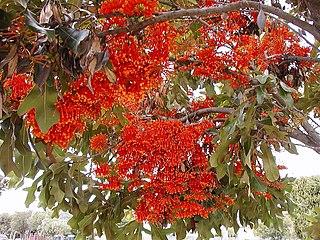
Stenocarpus is a genus of about 25 species of woody trees or shrubs, constituting part of the plant family Proteaceae.
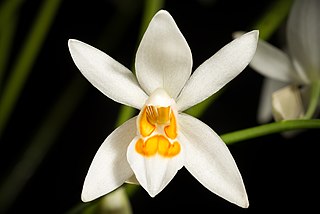
Coelogyne nitida is a species of orchid in the Coelogyne genus.
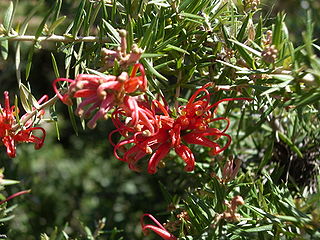
Grevillea juniperina, commonly known as juniper- or juniper-leaf grevillea or prickly spider-flower, is a plant of the family Proteaceae native to eastern New South Wales and south-eastern Queensland in Australia. Scottish botanist Robert Brown described the species in 1810, and seven subspecies are recognised. One subspecies, G. j. juniperina, is restricted to Western Sydney and environs and is threatened by loss of habitat and housing development.

Grevillea oldei is a shrub which is endemic to New South Wales in Australia.

Trevoa is a genus of actinorhizal plants; these dicotyledon flora are trees or small shrubs. The genus was first proposed by Miers in 1825, but was not fully described until 1830 by Sir William Jackson Hooker. Genus members are notable for their ability to fix nitrogen. Species of this genus are generally found in the near coastal forests and arid shrubland of South America. Some species are localized in the mountains of central Chile; for example, the species Trevoa trinervis occurs in the La Campana National Park and other proximate areas of central Chile.

Coelogyne corymbosa is a species of orchid.

Coelogyne miniata is a species of orchid.

Coelogyne parishii is a species of orchid.

Coelogyne rochussenii is a species of orchid.
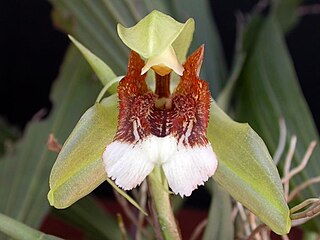
Coelogyne speciosa is a species of orchid.

Coelogyne tomentosa is a species of Orchid.
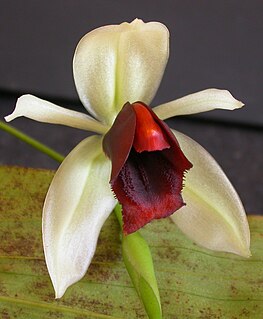
Coelogyne usitana is a species of orchid discovered in the late 1990s. It was named in honour of the collector Villamor T. Usita, by Jürgen Röth and Olaf Gruβ in the German orchid magazine Die Orchidee. It was discovered in central-east Mindanao, Philippines where it grows at elevations of about 800 metres on the horizontal branches of trees.

Coelogyne viscosa is a species of orchid.
Coelogyne vermicularis is a species of orchid in the genus Coelogyne.

Urera trinervis (Hochst.) Friis & Immelman is a softly woody dioecious liane, sometimes epiphytic, climbing to 20 m, often to the canopy and hanging in festoons. It is one of some 44 species of Urera belonging to the nettle family Urticaceae. It is known in English as the tree climbing-nettle or climbing nettle.
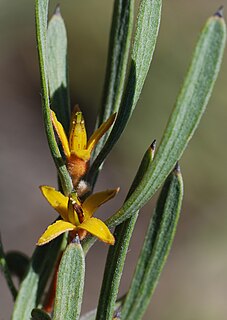
Persoonia trinervis is a species of flowering plant in the family Proteaceae and is endemic to the south-west of Western Australia. It is an erect, sometimes spreading shrub with densely hairy young branchlets, spatula-shaped or lance-shaped leaves with the narrower end towards the base, and densely hairy yellow flowers.

Stenocarpus trinervis is a species of rainforest tree in the family Proteaceae, endemic to New Caledonia. It may grow to 20 metres in height. The timber is beautifully marked, suited to cabinet making.
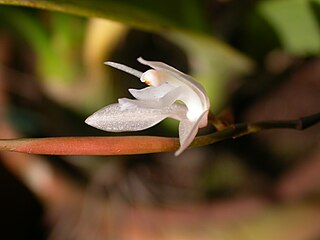
Coelogyne tiomanensis is an epiphytic orchid. It is endemic to Peninsular Malaysia.





















